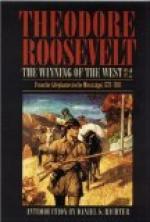It would be tiresome and profitless to so much as name the many different stations that were attacked. In their main incidents all the various assaults were alike, and that made this summer on McAfee’s station may be taken as an illustration.
The Attack on McAfee’s Station.
The McAfees brought their wives and children to Kentucky in the fall of ’79, and built a little stockaded hamlet on the banks of Salt River, six or seven miles from Harrodsburg. Some relatives and friends joined them, but their station was small and weak. The stockade, on the south side, was very feeble, and there were but thirteen men, besides the women and children, in garrison; but they were strong and active, good woodsmen, and excellent marksmen. The attack was made on May 4, 1781. [Footnote: McAfee MSS. This is the date given in the MS. “Autobiography of Robert McAfee”; the MS. “History of First Settlement on Salt River” says May 6th. I draw my account from these two sources; the discrepancies are trivial.]
The Indians lay all night at a corn-crib three-quarters of a mile distant from the stockade. The settlers, though one of their number had been carried off two months before, still continued their usual occupations. But they were very watchful and always kept a sharp look-out, driving the stock inside the yard at night. On the day in question, at dawn, it was noticed that the dogs and cattle betrayed symptoms of uneasiness; for all tame animals dreaded the sight or smell of an Indian as they did that of a wild beast, and by their alarm often warned the settlers and thus saved their lives.
In this case the warning was unheeded. At daybreak the stock were turned loose and four of the men went outside the fort. Two began to clear a patch of turnip-land about a hundred and fifty yards off, leaving their guns against a tree close at hand. The other two started towards the corn-crib, with a horse and bag. After going a quarter of a mile, the path dipped into a hollow, and here they suddenly came on the Indians, advancing stealthily toward the fort. At the first fire one of the men was killed,




